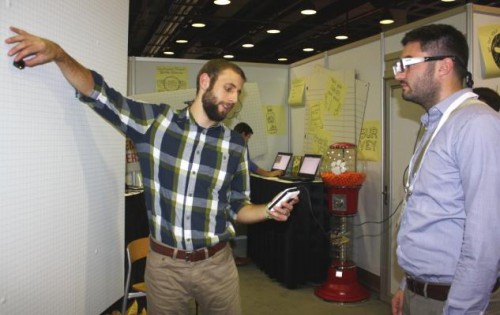Eye movement, blood flow and even skin reaction all go into a unique program at Clemson University to help determine whether that next plastic package — or any package for that matter — is going to be a hit or a miss or somewhere in-between. The approach, years in the making at the South Carolina school, is now being commercialized through a new company using these biometrics to help guide consumer product companies as well as packaging suppliers in their decision making.
“We’ve got this stuff down and we can pass this off to a local start-up company who can make a big difference and really utilize it and get it out into the industry and show off what we’re doing,” said R. Andrew Hurley, assistant professor in the Department of Food, Nutrition and Packaging Sciences at Clemson.
As part of the Sonoco Institute of Packaging Design and Graphics at the university, work on this approach dates back six years.
“There’s a lot of facets that you can apply this type of technology to. We work with leading eye-tracking software and hardware companies. We’ve highly customized commercial products to do this type of work,” Hurley said. “We can look at shelf impact and product viability. And we can do that from a very quantitative perspective.”
Clemson has its own store, of sorts, on campus. That’s where folks are invited in to shop, and their responses to specific packaging are recorded and then analyzed. Eye movement itself is tracked 30 times per second. And combined with all of the other metrics, a single shopping experience can yield more than 20 million pieces of data for analysis.
“We can quantifiably tell you if that’s going to increase attention, increase shelf impact and in the end is it going to increase your sales,” Hurley said about different packaging designs. That’s good for makers of consumer packaged goods as well as their packaging material suppliers.
“We can tell you with a very high confidence what structure or what substrate or what printing process really made a difference,” Hurley said.
Last year, he said, 93 percent of all new product launches to the fast food and consumer goods categories were failures.
“That’s a lot of money. That’s a lot of time. That’s a lot of waste,” he said.
But this research, he said, can help prove the viability of a package long before it hits the market. The laboratory at Clemson is called CUshop, which plays off of the university’s name as well as the mission of the work. The school set up a temporary version of the shop on the floor of Pack Expo this year in Chicago in space donated by show organizer PMMI, The Association for Packaging and Processing Technologies.
That’s where Drew Felty was hanging out. As an MBA graduate of Clemson, Felty helped create Package InSight, which has licensed the school’s CUshop approach.
“The value was just obvious to me,” Felty said. “As a lifelong consumer, I know it’s a visual environment. It’s discovering things about human behavior. As long as we’ve been around and as much as we know about ourselves, the fact that there still are things to discover there is still very interesting,” he said.
Package InSight launched earlier this year.
“We’ve had several customers since May and with those customers have learned a lot about ourselves and how to work together and learned how to scale the business,” he said.
Hurley said using the CUshop concept can shave months off of a product’s launch. “The average development cycle for a company is 22 months. This process can shorten that by about seven months, making you a market leader,” he said.
[via plastic news, images by Jim Johnson]



